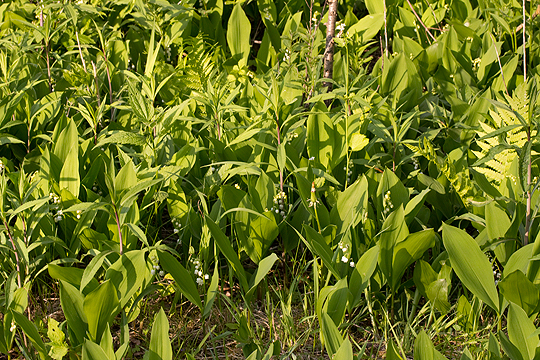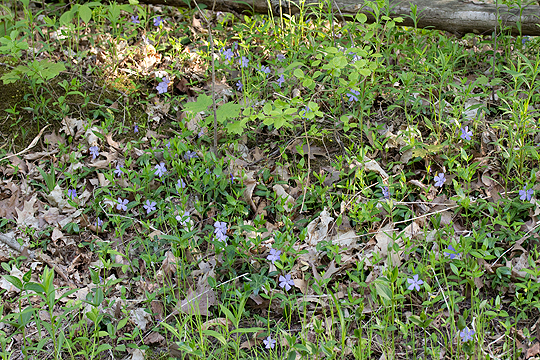An invasive species reproduces quickly enough to become an environmental threat and typically are introduced from elsewhere. These plants become invasive for any one of the following reasons:
1) They reproduce quickly
2) They produce large amounts of seed that may remain viable for a long time
3) They may chemically alter the soil by adding nitrogen, which speeds up the decomposition of leaf litter
4) They may release allelopathic chemicals that inhibit the growth of other plants
5) They may interfere with the fungal hyphae that interact with native plants
6) They may produce thick shallow root mats that deny other plants access to water
7) They may leaf out early and smother other plants
8) They may shade out other plants
9) They may hybridise with native plants rendering inedible to herbivores
10) And, in nearly all cases, there are few herbivores or diseases present to keep their populations in check.
Regardless of the modus operandi, invasive species reduce natural plant biodiversity which affects all the animals further up the food chain. Some of these plants are quite attractive to bees and butterflies, but this advantage must be weighed against the damage they do by destroying the food supply for many other animals.
| |
 |
|
| |
Lily of the valley in this case has escaped to invade a natural woodland. It was found nowhere near a garden. It is commonly planted in gardens. |
|
There are hundreds of invasive plant species in Ontario. Here is a list of some of the worst offenders:
| Name |
Notes |
| European Buckthorn |
This is one of the most invasive shrubs in Ontario with berries that pass quickly through the guts of birds and therefore spreading easily to other areas. They are nitrogen fixers as well so the soil chemistry is changed. |
| Norway Maple |
I simply do not understand why any municipality (such as the city of Toronto) would encourage the planting of these trees given that there are plenty of alternatives. Their seeds spread quickly to surrounding wooded areas. By casting heavy shade and using up the available moisture, shrubs and smaller trees that would ordinarily occupy part of the forest canopy are prevented from growing. |
| Mustard Garlic |
These plants outcompete other plants and may deter the growth of mycorrhizae that many native plants need. |
| Purple Loosetrife |
It is a wetland plant, but it even manages to turn up in my dry sandy garden. Each plant can produce millions of seeds and broken plants parts regenerate. Fortunately, some biological controls have been found to be useful. It is an attractive plant that pollinators like too, but please be responsible by planting Liatris instead. |
| |
 |
|
| |
This Periwinkle was outcompeting native plants in a woodland and taking over a large area of land. |
|
|
| Dog-Strangling Vine |
It takes over large swathes by smothering other plants. It also interferes with the reproductive cycle of the monarch butterfly. Hypena opulenta is currently being tested and released as a biological control. |
| Japanese Knotweed |
This is a tough plant to kill. You will be digging deep trenches if you decide you don't want it. It recolonises faster than native plants on disturbed areas and survives well in difficult growing conditions. The plant can look lovely, but planting it in your garden will lower the value of your home as people assess the cost of removing it. |
| Himalayan Balsam |
Another garden plant that does huge damage when it escapes. |
| Goutweed |
This plant will easily take over your garden if you are foolish enough to plant it. It does not typically spread beyond its physical borders. The beautiful variegated leaves are recessive. The plant will produce daughter plants with standard green leaves, which are even more aggressive. |
| Periwinkle |
Spreads easily once planted. Try something else. |
| Lily of the valley |
Too many people think this plant is pretty, but it can take years to get rid of it. |
Keeping invasive species at bay in your wildlife garden
1) Do not plant them. It is very tempting to plant Japanese Knotweed, Goutweed, Periwinkle or Lily of the valley because they grow so easily with so little maintenance required. These are the exact qualities that make them an ecological threat. If you or someone else later decide to remove them, it is going to be quite difficult and costly.
2) Monitor your garden on a regular basis and mark areas where you have found invasive species. Weed identification is an important part of prevention because it will define what strategies you will use. Seeds in the ground can remain viable for years so it is always a good idea to have a written record of where you should be looking for invasive species in your garden.
3) Pluck, pluck and pluck or cut, cut, and cut.
In a reasonable sized wildlife garden, hand weeding is an acceptable practice. Because weeds like most perennials store nutrients in their roots, it can take several years for the roots to stop growing back. Be prepared to weed several times a year for several years. It is vital that you pull weeds before the flowers appear. Once the flowerheads appear, a plant can persist until viable seeds are produced even if it has been pulled.
Learn about the weeds that you are pulling. There are quite a few plants that are poisonous to touch or which have sap that makes your skin blister in the presence of sunlight.
4) Do not compost weeds with flowerheads for the same reasons already mentioned. Instead, you should burn them or you can place them in a hot compost pile to sterilise the seeds.
5) Keep your equipment clean to avoid seed transfer
6) Avoid tilling the soil to expose new seeds.
7) Talk to your neighbours about dealing with weeds that go under the fence
Dealing with gardens that have gone out of control
If you move into a house where the garden has not been managed for a while, you may have a severe weed problem. It is often better in such circumstances to kill everything and start over because it saves you a lot of work down the road. If you are dealing with an area as large as a meadow, then you will simply not be able to weed. For large areas, you must be prepared to spend a year working on the weed issue so that your effort and time is not wasted. The garden in my school was overrun with goutweed. When we tried to save individual plants, we realised that the roots of the native plants were completely intertwined with the goutweed which then started resprouting in the pots. We had to dump the lot.
There are a few options:
1) A large amount of digging (not recommended for large areas)
2) Several layers of cardboard (or a plastic lining) topped with a thick layer of wood mulch.
3) Burning (although some seeds start germinating in these areas)
4) Herbicide.
I have never used herbicide and I think that generally it should not be used. Herbicides pose a risk to the environment by being persistent in the soil, polluting the groundwater supply and affecting the plants that are desirable. They also pose a risk to the people that apply the chemical and those who may be exposed to it following the application. It may be a suitable choice for someone with a large piece of land or with particular species that are almost impossible to kill by chopping alone. The risks should be carefully researched before making a decision to use herbicide.
With herbicides, you have to encourage the seeds and plants to grow using water and fertiliser and then kill them on a regular basis. This can be done several times over a year. The purpose of this is to reduce the amount of viable weed seed in situ. This is then followed up with a thick mulch to prevent any remaining seeds from sprouting and to keep new seeds from being blown in. (Greenlee and Diboll, 2011)
Reference: Invasive plants (2007) by S.R. Kaufman and W. Kaufman. This book is an absolutely excellent resource on this topic.
Reference: The New American Meadow (2011) by J. Greenlee and N. Diboll in The New American Landscape, Ed. C. Thomas.



